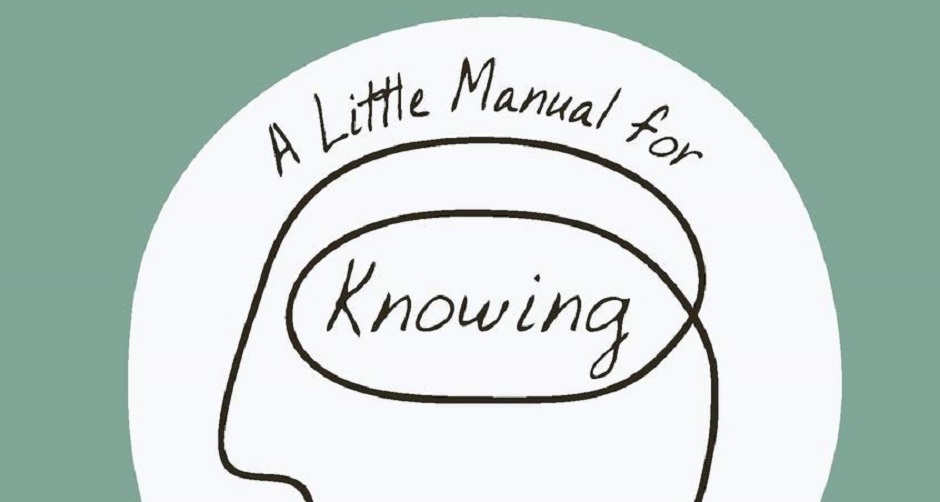Broadening the range of our capacity to wonder is at the heart of epistemology. To fail to do so is to slip dangerously into knowledge as impersonal and disembodied.
 Detail of the cover of the book.
Detail of the cover of the book.
"Esther Meek suggests that our first knowledge as human beings is the knowledge of being loved – in the wombs, at the breast, in the embraces of our mothers. This first knowledge, she suggests, is paradigmatic for all of our knowing. To know follows being known; being known is woven into being loved… this can shape our whole epistemology as scholars – shaping our understanding of knowing as a human being in all of life"
According to Gideon Strauss, of Fuller Theological Seminary in the USA, who is quoted above, this is the heart of the ‘Little Manual for Knowing’ – to know, follows being known. What is knowledge? What is the difference between ontology (what we can know) and epistemology (how we can know it)? What are concrete ideas about knowledge and about knowing?
These are the questions that Esther Meek tackles in this provocative book on how we can know things (epistemology). Right at the outset, she addresses the dominant philosophical questions not just of our time but across centuries. What is really real? (metaphysics/ontology). How do I know it? (epistemology). What is right and good? (metaethics & axiology). What does it mean to be human? (anthropology). Meek suggests that ‘our entire lives sail on the breast of these deep questions’ (p.2).
The axiom of the book is founded on a rejection of mainstream ‘knowledge-as-information’ thinking. Meek writes (p.48) that ‘the common knowledge-as-information approach casts knowing as collecting information. It presumes that the information is entirely clear. All information can be verbally expressed in sentences. It just needs transferring, impersonally, from its impersonal source to us. No personal investment is involved. Information is what it is without our indwelling it’.
The book is divided into two parts – first section on pilgrimage, and second section on gift. The book charts a course of mutuality in knowledge and knower – the two can never be separated and mutuality between the two grows as a new venture is boarded. Part one considers love, pledge, invitation, and indwelling. Part two looks at encounter, transformation, dance, and shalom.
The work concludes with an appreciation for the knower and for knowledge in ‘the encounter of insight, [where] we find ourselves transformed, [and] embedded more deeply in a change reality, one that is fraught with meaning and pregnant with future prospects’ (p.98).
 Esther Lightcap Meek. / Photo: Facebook of the author
Esther Lightcap Meek. / Photo: Facebook of the author[photo_footer] Esther Lightcap Meek. / Photo: Facebook of the author [/photo_footer] Broadly speaking, ‘A Little Manual for Knowing’ is an affront to mainstay Western culture. The book rejects impersonal information. It also rejects knowledge ‘without our indwelling it’ (p.48). Meek valiantly declares; ‘trust isn’t a bare collection of obvious facts. It is a profession of allegiance – a highly sophisticated, pledge-like human act’ (p.69). As such ‘knowledge-as-information’ (ibid.) is rejected. Likewise, ‘loving-in-order-to-know’ (ibid.) is fallacious, an untrue orientation toward knowing.
Meek draws etymological links to point to the fundamental roots of our knowledge. At the outset of the book, she draws our attention to the word truth. ‘The word “truth” is related to the old word “troth”. Troth means a solemn pledge of faithfulness in relationship, as in a marriage vow. This link powerfully underscores that pledge and trust are the central nerve of knowing’ (p.29). In the quest for truth – or what Meek refers to as the ‘knowledge venture’ – we are recommended to choose wise guides. Meek writes that ‘we should choose people who are strategically qualified to help us. They expertly know something we need to know in our knowing venture. We should choose guides who also love what they know. They should be excited about it, delighted in it’ (p.42).
Rather than furthering the ‘knowledge-as-information’ (p.69) orientation, Esther Meek does well to demonstrate our fundamental participation in knowledge (and truth) creation. She writes (p.20) that ‘it takes love to notice and to wonder. A reality where love is at the core of all things is one attuned to be seen only through eyes of love. Only when we first love do we being to attend, to listen, to understand, to know’. Quite on the contrary, reality does not disclose itself to ‘uncaring, indifferent, suspicious, “knowers”’ (ibid.). Wonder, then, is front and centre. Broadening the range of our capacity to wonder is at the heart of her epistemology. To fail to do so is to slip dangerously into knowledge as impersonal and disembodied.
She suggests (p.20) that we ‘should cultivate wonder – a posture of wonder. This is a trained readiness to be astounded. The readiness is that of a lover anticipating being delighted’ (ibid.). On love, Esther Meek speaks with insight. In relational form, she writes (p.18) that ‘love accords space and true otherness to the other rather than seeking to absorb it. It involves a pledge to accord space and dignity to the other. On the other hand, she suggests (ibid.) that ‘obsession is an unhealthy form of relating to something. It is selfish and possessive, driven by power. We should not call it love’.
Meek lists (p.71) a number of features of ‘epiphanies in our knowing ventures’. These reflect the ‘true encounter’ in the moment of communion between knower and known. Meek (p.66) suggests that our love invites the real, ‘the real comes into our love and flourishes there. The relationship we have with it is invested, compassionate, connected. It’s not a mercenary help-yourself. We didn’t invite it by exhibiting that attitude. Now it stands before us in our delight and wonder. Now it stands before us in mutual consent’. The features of this encounter are varied and lengthy – some recognised elements include: joy and delight; a sense of grace; a shift from active to passive; connected with situation and body sense; maturation into self-giving love; finding and being found; knowing and being known.
Meek writes that ‘God is the ultimate other’ (p.39). In our pursuit of truth outside of ourselves, there is no greater source of gracious, embedded care and compassion than in the loving gaze of the God of the Bible. She continues; ‘God is the ultimate other person who comes into our Void and delivers us in gracious love. We can live joyously and freely and for him. We live fully in his delighted regard. It matures us in the best way to be selves who give in love’ (ibid.).
Samuel Johns is a writer and a social entrepreneur, working in both western Europe and Asia (Nepal).

Las opiniones vertidas por nuestros colaboradores se realizan a nivel personal, pudiendo coincidir o no con la postura de la dirección de Protestante Digital.
Si quieres comentar o